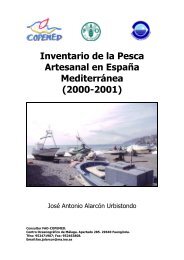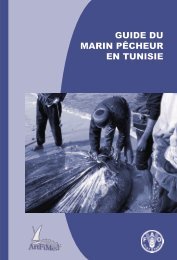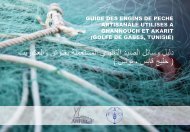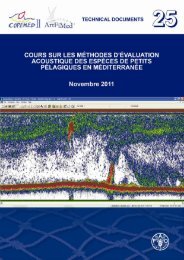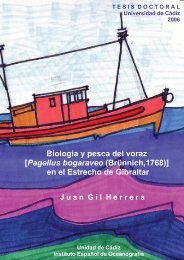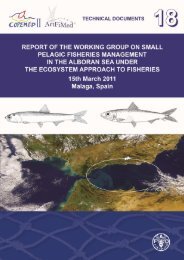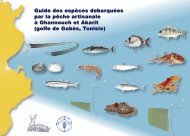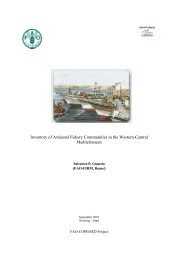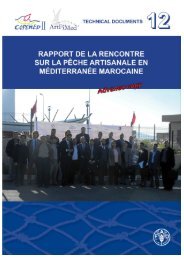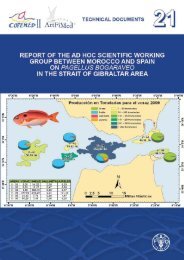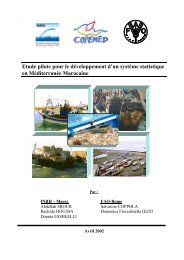Methods for Assessing Mediterranean Fisheries - Fao - Copemed
Methods for Assessing Mediterranean Fisheries - Fao - Copemed
Methods for Assessing Mediterranean Fisheries - Fao - Copemed
Create successful ePaper yourself
Turn your PDF publications into a flip-book with our unique Google optimized e-Paper software.
<strong>Methods</strong> <strong>for</strong> <strong>Assessing</strong> <strong>Mediterranean</strong> <strong>Fisheries</strong><br />
Pere Oliver<br />
all boats over 15 m was important, even prior to ratification of that Agreement,<br />
and would constitute a de facto commitment to flag State responsibility.<br />
55. The Secretariat was requested to prepare a simple and<br />
comprehensive questionnaire to collect data on fishing vessels and<br />
distribute it immediately to all member countries. The Council agreed to a<br />
deadline <strong>for</strong> submission to the Secretariat of complete data on national fishing<br />
fleets operating in the <strong>Mediterranean</strong> in 1994-5 by the time of the October 1995<br />
meeting of the FAO Council. The data should be broken down into vessel<br />
categories over and under 15m OAL (overall length), and these two categories<br />
should in turn, be divided into sub-categories of vessels predominantly operating<br />
active and passive fishing gear respectively. Each sub-category should include a<br />
breakdown of vessels by total HP and/or total Gross Registered Tonnage (GRT)<br />
as available.<br />
At this meeting the following resolution was also adopted:<br />
GFCM Resolution 95/4<br />
The Council calls on its member countries to prepare a list of<br />
fishing boats in operation from national ports in the <strong>Mediterranean</strong> and<br />
provide this in<strong>for</strong>mation to the GFCM Secretariat by October 1995 in the<br />
<strong>for</strong>m specified in the report of the Twenty-first Session of the General<br />
<strong>Fisheries</strong> Council <strong>for</strong> the <strong>Mediterranean</strong>.<br />
Un<strong>for</strong>tunately, seven years later the list of fishing boats in operation from<br />
national ports in the <strong>Mediterranean</strong> has still not been completed.<br />
In July 1995 a Group of Independent Experts to Advise the European<br />
Commission on the Fourth Generation of Multi-annual Guidance<br />
Programmes was established to report to the European Commission. The work<br />
carried out by this group is relevant regarding the establishment of an ef<strong>for</strong>tcontrol<br />
system in <strong>Mediterranean</strong> fisheries, based on the assessment of levels of<br />
fishing mortaly.<br />
Ef<strong>for</strong>t is a measure of the activity of the fishing fleet. The term is, however,<br />
ambiguous as it is used in two different contexts: As a measure proportional<br />
to the fishing mortality (<strong>Fisheries</strong> biology), but also as a measure<br />
proportional to the variable costs of the fishing vessel (<strong>Fisheries</strong><br />
economics).<br />
One of the key problems in reducing fishing mortality through ef<strong>for</strong>t<br />
control is to ensure that the ef<strong>for</strong>t parameters which are selected <strong>for</strong><br />
control are relevant to fishing mortality. There are numerous examples of<br />
attempts to control ef<strong>for</strong>t through decommissioning, reduction of allowable days<br />
at sea etc. which have failed to achieve the primary objective, to reduce fishing<br />
mortality.<br />
16




